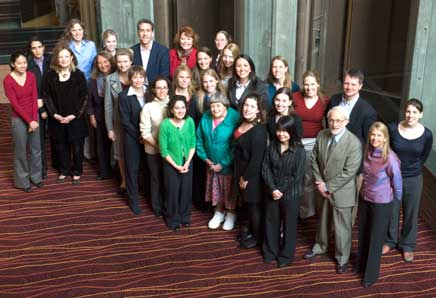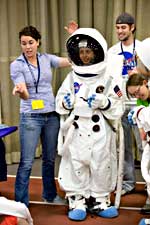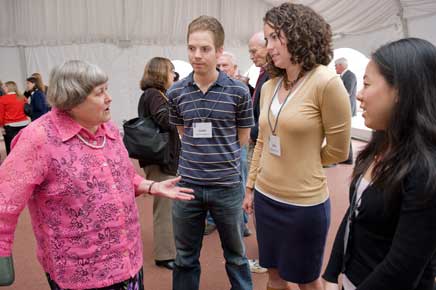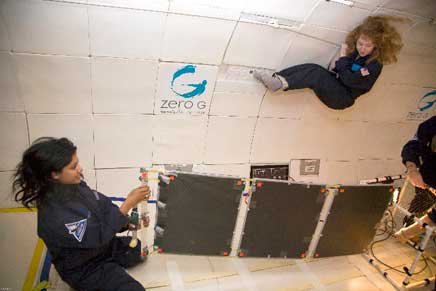|
AeroAstro Magazine HighlightThe following article appears in the 2008–2009 issue of AeroAstro, the annual report/magazine of the MIT Aeronautics and Astronautics Department. © 2009 Massachusetts Institute of Technology. More Giant Leaps: Women in Aerospace, Outreach Programs, Gardner Lecture, and Zero GWomen in Aerospace
|
||||||||||||||
 |
At the April 2-3 Women in Aerospace Conference, doctoral candidates joined professionals from academia, industry, and government to present research and to network. The conference will be an annual event. |
As part of Giant Leaps focus on the future of aerospace, on April 2 and 3, 2009 AeroAstro and the Department of Earth, Atmospheric, and Planetary Sciences jointly hosted the Women in Aerospace Symposium. Twelve women who are advanced doctoral candidates were nominated as participants by leading academic programs around the country. Also in attendance were professionals from academia, industry, and government. The symposium offered women who we expect to be future leaders a unique forum to present their research to both peers and pros. The opportunities for connection, networking, mentoring, and kindling relationships were unparalleled. Presentations were:
Our expectations for the event were more than fulfilled. Feedback was so overwhelmingly
positive that the event will become an annual event. We know it will grow and evolve, and yet we are committed to maintaining the event’s atmosphere of one-on-one collegiality, camaraderie, and connectivity.
by the MIT Office of Engineering Outreach Program
AeroAstro grad student volunteers Allie Anderson (left) and Brad Holschuh help a young visitor experience a “space suit” at the Cambridge Science Festival. (Michael Fein/Cambridge Science Festival photo) |
 |
During the many activities taking place at MIT to celebrate the 40th anniversary of the Apollo moon landing it was hard not to notice the younger faces in crowds.The MIT Department of Aeronautics and Astronautics teamed up with the MIT Office of Engineering Outreach Programs, to provide exciting opportunities for middle and high school students from Boston, Cambridge, and Lawrence, Massachusetts. Our goal was to influence students to learn more about the history and future of aerospace exploration.
OEOP’s Saturday Engineering Enrichment & Discovery Academy, an enrichment program for local public high school students, kicked off its spring 2009 term with it’s own commemoration of the first human landing on the moon. SEED Academy highlighted this celebration with speaker Dr. Jeffrey Hoffman, former astronaut and AeroAstro professor of the practice, at its orientation event on Feb. 7, 2009. The Apollo Outreach Committee also contributed to the planning and development of a semester-long Aeronautics and Astronautics curriculum and course for SEED Academy’s high school sophomores.
We also focused on exposing students to fields related to science and engineering. On April 1, committee members participated in the Aviation/Transportation Education expo at Logan Airport to promote the field of aerospace exploration to more than 1,000 Boston area K-12 students. On Saturday, May 2, AeroAstro hosted the Sally Ride Science Festival as a part of the Cambridge Science Festival. This day-long event was aimed at encouraging young people to pursue their passion for exploration in science, math, and engineering. Approximately 1,000 middle school students enjoyed the festival which included a motivational talk by Dr. Ride, the first American woman to fly in space; discovery workshops presented by local scientists and engineers; workshops for parents and teachers on ways to support students’ interests in science and math; and a street fair with booths, hands-on activities, food and music. As a special gesture to end the festivities, and as a way to inspire tomorrow’s engineers, 200 OEOP students and their families attended the Boston Pops performance, narrated by Apollo astronaut and AeroAstro alumnus Buzz Aldrin.
 |
2009 Lester D. Gardner lecturer |
The April 2-3, 2009 Women in Aerospace Symposium was the venue for AeroAstro’s annual Lester D. Gardner Lecture. The speaker, Yvonne Brill, is a veteran of 60 years in aerospace engineering and a pioneer in space propulsion. She is a revered mentor and role model for aspiring young women engineers
Brill’s lecture, “Megabytes for the Masses,” provided a history of the beginnings and evolution of earth observation and commercial communication satellites. She discussed her experiences in developing onboard rocket propulsion systems that ensure that satellites maintain prescribed orbits and can relay data to earth. She also shared her perspectives on doing pioneering work in spacepropulsion at a time when there were few women in the field, why she chose engineering, and why engineering is an exciting and rewarding career.
Gardner Lectures, which focus on aerospace history, are funded by a bequest of the late Major Lester D. Gardner, an 1898 MIT graduate who was instrumental in creating the Aeronautics and Astronautics Department’s Hunsaker Professorship in Aeronautical Engineering.
by Erika Wagner
Thirty MIT students, faculty, and staff. A Boeing 727-200 called “G Force One.” And, a swath of airspace 100 miles long by 10 miles wide. Add to these a pilot trained to fly in 10,000 foot roller coasterlike parabolas and you get one incredible research opportunity. With support from Massachusetts Space Grant, NASA, ESA, and others, MIT took to the Florida skies in June as an adjunct to the Giant Leaps events, offering students the opportunity to conduct research while in a reduced gravity environment. Experiments ranged from studying how microgravity can be used to improve the nanostructural characteristics of aerogels, to lunar-g effects on astronauts’ perception of slopes and distances on the moon’s surface — a critical task for future exploration. Students examined deployment dynamics of a solar panel for an orbital debris tracking satellite, the first flight of a novel air-ionizing propulsion system, and multi-environment functionality of biosatellite habitat systems. ZERO-G Corp., which operates these flights out of airports across the country, was co-founded by Course 16 alumni Peter Diamandis (‘88) and Byron Lichtenberg (‘75, ‘79).
Aboard the Zero G flight, Tina Srivastava (left) and Jillian James test microgravity deployment of a solar panel for an undergrad satellite project. (Steve Boxal/Zero Gravity Corp. photo) |
 |
From June through September 2009, the MIT Museum hosted the exhibit “MIT Goes to theMoon.” The display included rare Apollo-era artifactsthat tell the story of MIT's major contributions to the American space program. Included werean extremely rare Apollo Guidance, Navigation, and Control system simulator on loan from Draper Laboratory for its first public showing.
 |
MIT Museum science and technology curator Debbie Douglas explains the Apollo Guidance, Navigation, and Control simulator to BBC science correspondent Tom Feilden. (William Litant/MIT photo |